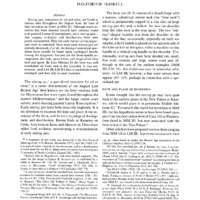The Origin of the Aegean Stirrup Jar and its Earliest Evolution and Distribution (MB III-LB I)
Item
-
Title
The Origin of the Aegean Stirrup Jar and its Earliest Evolution and Distribution (MB III-LB I)
-
Identifier
Haskell, H. (1985). The Origin of the Aegean Stirrup Jar and Its Earliest Evolution and Distribution (MB III-LBI). American Journal of Archaeology, 89(2), 221-229. doi:10.2307/504326
-
uri
https://collections.southwestern.edu/s/suscholar/item/502
-
Abstract
Stirrup jars, containers for oil and wine, are found at various sites throughout the Aegean from the time of their invention on Crete in MM III. Although much attention has been directed toward later versions (some with painted Linear B inscriptions), early stirrup jars-- their origins, evolution, and distribution-have been poorly documented. Here the early history of this important vessel is examined. Since most early stirrup jars are sparsely decorated, if at all, the dating of individual specimens must usually be based upon typological details. Among the diagnostic features are the three-handle arrangement, disc hole, spout horns, and shape of the false neck and spout. By Late Minoan IA the form was well established on Crete and in the Cyclades. It was not, however, until LM IB/LH IIA that it reached the Greek mainland, and then only in small numbers.
-
Publisher
American Journal of Archaeology
-
Subject
Stirrups
Amphorae
Pottery
Vases
I Houses
Excavations
